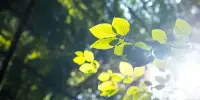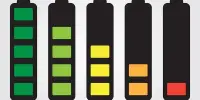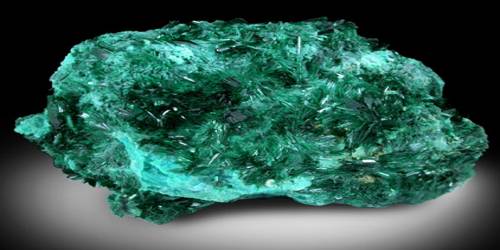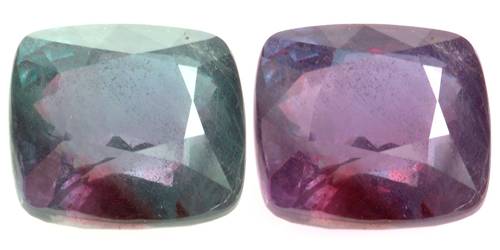Three scientists were awarded the Nobel Prize in chemistry on Wednesday for their work on quantum dots, which are small particles a few nanometers in diameter that can emit very brilliant colored light and have uses in electronics and medical imaging.
The Royal Swedish Academy of Sciences honored Moungi Bawendi of MIT, Louis Brus of Columbia University, and Alexei Ekimov of Nanocrystals Technology Inc. for their work with the tiny particles that “have unique properties and now spread their light from television screens and LED lamps,” according to the Royal Swedish Academy of Sciences, which announced the award in Stockholm.
The anticipation surrounding the academy’s selection took an unusual turn when Swedish media announced the winners many hours before the award was given out. The early alert was allegedly caused by an error in a news release.
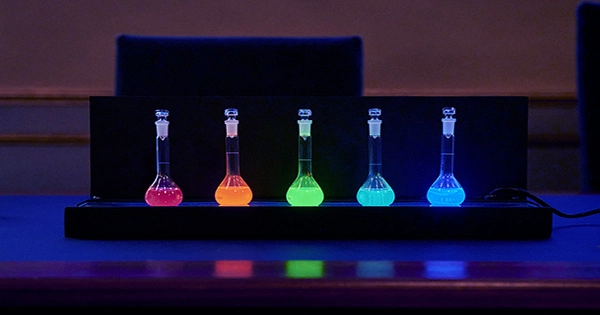
What discovery won the Nobel Prize in chemistry?
When exposed to light, quantum dots glow in a spectrum of hues ranging from red to blue. The color they emit is determined by the particle’s size.
Scientists can engineer the dots out of materials ranging from gold to graphene to cadmium, and adjust their size to change their hue. Blue light is emitted by the smallest particles, in which electrons are most closely packed. Red light is emitted by somewhat larger particles in which electrons bounce over a longer wavelength.
Chemists will occasionally compare the particle’s size to a confining box.
Nearly a century ago, the underlying “particle in a box” theory of quantum mechanics was described. However, it took several decades for scientists to be able to produce quantum dots in a lab.
In the 1980s, Ekimov, 78, and Brus, 80, refined the theory and pioneered early experimental procedures for producing particles with changing hues by modifying their sizes. Bawendi, 62, invented new chemical ways for generating the particles swiftly and uniformly in 1993, paving the way for a wide range of scalable commercial uses, including electronic displays.
The American Chemical Society’s president, Judy Giordan, expressed her delight in this year’s winners.
“What we care about a lot in chemistry is being able to make and tailor novel structures and architectures to solve problems that help people and the planet,” he said.
According to Rigoberto Advincula, a materials chemist at Tennessee’s Oak Ridge National Laboratory, the effort helped bridge the worlds of physics and chemistry, adding, “This technology is very easy to reproduce—that’s why it became so popular and widespread.”
Quantum dots are widely employed in electronic displays and biological imaging nowadays. The particles’ fluorescent properties enable researchers to follow how medications are distributed throughout the human body, as well as examine the precise location and progress of a tumor, for example.
Were the winners announced too early?
Swedish media claimed hours before the announcement on Wednesday that the Royal Swedish Academy of Sciences had issued a press release naming Bawendi, Brus, and Ekimov as the latest Nobel laureates.
According to the statement, they were awarded the prize for the “discovery and synthesis of quantum dots.”
After officially announcing the three winners, Swedish Academy Secretary-General Hans Ellegren stated that the Swedish Academy would look into how the information got out so early.
“A press release was distributed for unknown reasons.” “We’ve been working hard this morning to figure out exactly what happened,” he said. “This is very unfortunate and we deeply regret what happened.”
The academy, which grants physics, chemistry, and economics prizes, solicits suggestions from hundreds of university professors and other researchers worldwide a year in advance.
A committee for each prize then meets to discuss contenders before proposing one or more suggestions to the entire academy for a vote. The process, including the names of nominees other than the winners, is kept secret for 50 years.
How did the winners react?
Bawendi stated during the press conference that he was “very surprised, sleepy, shocked, unexpected, and very honored.”
When asked about the leak, he stated he didn’t realize he’d been named a Nobel winner until the academy called him.
Bawendi stated that when he began researching quantum dots, he was not thinking about the potential uses of his work.
“The motivation is fundamental science.” A fundamental grasp, as well as an interest in how the world works. And it is what motivates scientists and academic scientists to conduct their work,” he remarked.
Brus, an emeritus professor at Columbia, said he didn’t pick up the phone when the Swedish academy called to alert him in the early morning.
“It was ringing during the night, but I didn’t answer it because I’m trying to get some sleep, basically,” he explained to The Associated Press. When he woke up at about 6 a.m., he finally saw the news online.
“I was certainly not expecting this,” Brus said.
Brus expressed gratitude for the acknowledgment of the field of chemistry in which he works. He had hoped for practical applications of quantum dots, such as producing the colors in flatscreen TVs, when he began his research decades ago.
“Basic research is extremely hard to predict exactly how it’s going to work out,” Brus pointed out. “It’s for the knowledge base rather than the actual materials.” However, in this situation, it is both.”
Ekimov was the former chief scientist at Nanocrystals Technology, a New York-based corporation where he began working in 1999. In the early 1980s, he demonstrated to the Swedish Academy that the size of copper chloride nanoparticles altered the colors in glass.
“It was really nice that we got it after 40 years of hard work,” Ekimov said to the Associated Press. His first book on the subject was published in 1981.
The physics prize was awarded to French-Swedish physicist Anne L’Huillier, French scientist Pierre Agostini, and Hungarian-born Ferenc Krausz on Tuesday for creating the first split-second view into the super-fast world of spinning electrons.
On Monday, Hungarian-American Katalin Karikó and American Drew Weissman were awarded the Nobel Prize in medicine for their discoveries that enabled the development of COVID-19 mRNA vaccines.
The prizes for literature, peace, and economics will be announced each workday until Monday.
The Nobel Prizes are endowed with a financial prize of 11 million Swedish kronor ($1 million) left by the prize’s originator, Swedish inventor Alfred Nobel.
Nobel Committee announcement:
The Royal Swedish Academy of Sciences has decided to award the Nobel Prize in Chemistry 2023 to
Moungi G. Bawendi
Massachusetts Institute of Technology (MIT), Cambridge, MA, U.S.
Louis E. Brus
Columbia University, New York, NY, U.S.
Alexei I. Ekimov
Nanocrystals Technology Inc., New York, NY, U.S.
“for the discovery and synthesis of quantum dots”
They planted an important seed for nanotechnology
The Nobel Prize in Chemistry 2023 honors the discovery and development of quantum dots, nanoparticles so small in size that their properties are determined by their size. These nanotechnology’s tiniest components now diffuse light from televisions and LED lamps, and can also direct surgeons when removing tumor tissue, among other things.
Everyone who studies chemistry knows that the number of electrons in an element determines its qualities. However, as matter shrinks to nano-dimensions, quantum phenomena emerge, which are governed by the matter’s scale. The Nobel Laureates in Chemistry 2023 have succeeded in generating particles so tiny that quantum phenomena govern their behavior. The particles, known as quantum dots, are now extremely important in nanotechnology.
“There are many fascinating and unusual properties of quantum dots.” “Most importantly, they have different colors depending on their size,” explains Nobel Committee Chair Johan Qvist.
Physicists have long suspected that size-dependent quantum phenomena may occur in nanoparticles, but it was nearly difficult to sculpt in nano-dimensions at the time. As a result, few people believed that this knowledge would be put to use.
Alexei Ekimov, on the other hand, succeeded in establishing size-dependent quantum effects in colored glass in the early 1980s. The color came from copper chloride nanoparticles, and Ekimov demonstrated how particle size altered the color of the glass via quantum effects.
Louis Brus was the first scientist in the world to demonstrate size-dependent quantum effects in particles floating freely in a fluid a few years later.
Moungi Bawendi revolutionized the chemical manufacturing of quantum dots in 1993, resulting in nearly flawless particles. This level of quality was required for them to be used in applications.
Quantum dots are currently used to light computer monitors and television screens that use QLED technology. They also improve the brightness of some LED bulbs and are used by biochemists and doctors to map biological tissue.
Thus, quantum dots provide the biggest value to humanity. Researchers predict that in the future, these tiny particles could contribute to flexible electronics, tiny sensors, thinner solar cells, and encrypted quantum communication—so we have only begun to explore their possibilities.
They infused color into nanotechnology: The Nobel Prize in Chemistry 2023 is awarded to Moungi G. Bawendi, Louis E. Brus, and Alexei I. Ekimov for the discovery and development of quantum dots. These microscopic particles have distinct properties and are already emitting light from television screens and LED bulbs. They catalyze chemical reactions and provide a clear light that can be used to illuminate tumor tissue for surgeons. “Toto, I’ve got a feeling we’re not in Kansas anymore,” is a famous line from the film The Wizard of Oz.
Dorothy, twelve, faints onto her bed after her house is blown away by a huge tornado, but all changes when the house lands again and she steps outside the door with her dog Toto in her arms. She finds herself in a magnificent, technicolor universe.
We would most likely be as surprised as Dorothy in the Land of Oz if an enchanted whirlwind swept into our lives and shrunk everything to micro dimensions. Everything would alter and our surroundings would be dazzlingly colorful. Our gold earrings would suddenly become blue, while the gold ring on our finger would turn ruby red.
The frying pan might melt if we tried to fry something on the gas stove. And our white walls, whose paint contains titanium dioxide, would begin to produce a large number of reactive oxygen species.
Size matters on the nanoscale: Things do behave differently in the nanoworld. When the scale of the matter is measured in millionths of a millimeter, weird phenomena called quantum effects begin to emerge, challenging our intuition. The 2023 Nobel Laureates in Chemistry have all been forerunners in the study of the nanoworld. In the early 1980s, Louis Brus and Alexei Ekimov separately created quantum dots, which are nanoparticles so small that quantum effects govern their properties. Moungi Bawendi revolutionized the processes for manufacturing quantum dots in 1993, resulting in extraordinarily high quality—a necessary prerequisite for their application in today’s nanotechnology.
Because of the laureates’ efforts, humanity can now take advantage of some of the distinctive qualities of the nanoworld. Quantum dots are currently used in commercial items and in numerous scientific disciplines, ranging from physics and chemistry to medicine—but we’re getting ahead of ourselves. Let’s go into the history of the Nobel Prize in Chemistry 2023.
For decades, quantum phenomena in the nanoworld were just a prediction: When Alexei Ekimov and Louis Brus created the first quantum dots, scientists already knew they could have strange properties. Herbert Fröhlich, a physicist, predicted in 1937 that nanoparticles would not behave like normal particles. He investigated the theoretical implications of the renowned Schrödinger equation, which states that when particles grow incredibly small, there is less space for the electrons of the material. The electrons, which are both waves and particles, are then pressed together. Fröhlich recognized that doing so would result in significant changes to the material’s characteristics.
This revelation captivated researchers, who were able to predict numerous size-dependent quantum effects using mathematical methods. They also worked to display them in real life, but this was more difficult than it seemed because they needed to create a structure a million times smaller than a pinhead.
Few people thought quantum effects could be utilized: Nonetheless, in the 1970s, researchers were successful in creating such a nanostructure. They generated a nano-thin layer of coating material on top of a bulk material using a form of molecular beam. Once the construction was complete, scientists were able to demonstrate that the optical properties of the coating varied depending on how thin it was, a result that corresponded to quantum mechanics expectations.
This was a significant breakthrough, but the experiment required cutting-edge technology. Few people expected quantum mechanical phenomena to be used in practice because researchers need an ultra-high vacuum and temperatures near absolute zero. However, science occasionally surprises us, and this time the turning point was owing to research into an ancient invention: colored glass.
A single substance can give glass different colors: The oldest archaeological finds of colored glass date back thousands of years. Glassmakers have put their theories to the test in order to figure out how to build glass in every color of the rainbow.
They added silver, gold, and cadmium, then experimented with different temperatures to create gorgeous hues of glass. When physicists began to examine the optical properties of light in the nineteenth and twentieth centuries, glassmakers’ knowledge was put to use. Physicists may filter out specific wavelengths of light using colored glass. To improve their experiments, they began producing glass themselves, which led to major discoveries. They discovered that a single material may produce completely different colored glass. A mixture of cadmium selenide and cadmium sulfide, for example, might color glass yellow or red, depending on how hot the molten glass was and how quickly it cooled. They were eventually able to demonstrate that the colors came from particles forming inside the glass and that the color depended on the size of the particles.
This was the state of knowledge at the end of the 1970s, when one of this year’s laureates, Alexei Ekimov, a recent doctoral graduate, began working at what was then the Soviet Union’s S. I. Vavilov State Optical Institute.
Alexei Ekimov investigates the mysteries of colored glass: Alexei Ekimov was intrigued by the concept that a single chemical might result in different colored glass because it is nonsensical. Unless you mix in other pigments, if you paint an image with cadmium red, it will always be cadmium red. So, how could the same material produce glass of various colors?
During his doctoral studies, Ekimov focused on semiconductors, which are critical components in microelectronics.
Optical methods are employed as diagnostic tools in this field to examine the quality of semiconducting material. The absorbance of the material is measured by shining a light on it. This tells what materials are used and how well-ordered the crystal structure is.
Because Ekimov was familiar with these techniques, he began employing them to investigate colored glass. Following some first trials, he decided to create copper chloride-tinted glass on a large scale. He heated the molten glass to temperatures ranging from 500°C to 700°C, adjusting the heating time from 1 hour to 96 hours. He X-rayed the glass after it had cooled and solidified.
The dispersed rays revealed that tiny crystals of copper chloride had grown inside the glass, and the size of these particles was affected by the production process. They were as small as two nanometres in some of the glass samples and as large as 30 nanometres in others.
Surprisingly, the size of the particles had an effect on the glass’s light absorption.
The largest particles absorbed light in the same way as copper chloride does ordinarily, but the smaller the particles, the bluer the light absorbed. As a physicist, Ekimov was well-versed in quantum mechanics laws and instantly realized that he had experienced a size-dependent quantum effect (fig. 3).
This was the first time someone had intentionally created quantum dots—nanoparticles that cause size-dependent quantum effects. Ekimov published his discovery in a Soviet scientific journal in 1981, but access to it was difficult for scholars on the other side of the Iron Curtain. As a result, Louis Brus, this year’s Nobel Laureate in Chemistry, was uninformed of Alexei Ekimov’s discovery when, in 1983, he was the first researcher in the world to find size-dependent quantum effects in particles floating freely in a solution.
Brus shows that the strange properties of particles are quantum effects: Louis Brus was working at Bell Laboratories in the United States, with the long-term goal of using solar energy to power chemical operations. He was doing this by employing cadmium sulfide particles, which can collect light and then use their energy to drive reactions. The particles were in a solution, and Brus reduced their size to provide him with a bigger surface area on which the chemical reactions could occur; the more a material is diced up, the more surface area it exposes to its environment.
Brus noticed something peculiar while working with these tiny particles: their optical qualities changed after he left them on the lab bench for a time. He reasoned that this could be because the particles had grown, so he created cadmium sulphide particles around 4.5 nanometres in diameter to confirm his assumptions. The optical properties of these freshly created particles were then compared to those of the larger particles, which had a diameter of roughly 12.5 nanometres. The larger particles absorbed light at the same wavelengths as cadmium sulphide, but the smaller particles absorbed light at a bluer wavelength.
Brus, like Ekimov, realized he had witnessed a size-dependent quantum effect. He announced his discovery in 1983 and subsequently began researching particles manufactured from a variety of other materials. The pattern was consistent: the smaller the particles, the more blue light they absorbed.
The periodic table gained a third dimension: “Why does it matter if a substance’s absorbance is slightly more towards blue?” you may wonder. “What makes that so incredible?”
The optical alterations, on the other hand, demonstrated that the substance’s properties had completely changed. The optical characteristics of a substance are determined by its electrons. Other features of the substance, such as its ability to catalyze chemical reactions or conduct electricity, are likewise governed by the same electrons.
When researchers noticed the altered absorption, they realized they were dealing with an altogether new substance.
To grasp the significance of this discovery, imagine the periodic table suddenly gaining a third dimension. The number of electron shells and the amount of electrons in the outer shell affect an element’s properties, but size also matters at the nano level. A chemist who wished to create a novel substance now had another factor to work with—of course, this piqued the interest of researchers!
There was only one issue. Brus’ methods for producing nanoparticles were often unreliable in terms of quality. Quantum dots are tiny crystals (fgure 2), and the ones that could be made at the time were frequently flawed. They were also different sizes. It was feasible to manipulate how the crystals formed so that the particles had a specific average size, but if researchers wanted all the particles in a solution to be roughly the same size, they had to sort them after they were produced. This was a difficult procedure that stifled growth.
Moungi Bawendi revolutionizes the production of quantum dots: This was the dilemma that this year’s third Nobel Laureate in Chemistry set out to tackle.
Moungi Bawendi began his postdoctoral studies in 1988 in Louis Brus’ laboratory, where intensive work was being done to improve the methods used to create quantum dots. They worked with a number of chemicals using a variety of solvents, temperatures, and procedures in order to generate well-organized nanocrystals. And the crystals were improving, but still not good enough.
Bawendi, on the other hand, did not give up. He continued his efforts to develop higher-quality nanoparticles when he began working as a research leader at the Massachusetts Institute of Technology, MIT. In 1993, the research team made a significant breakthrough by injecting the ingredients that would form nanocrystals into a heated and precisely chosen solvent. They injected as much of the chemicals as was required to precisely saturate the solution, resulting in the formation of small crystal embryos at the same time.
Moungi Bawendi and his research team were then successful in generating nanocrystals of a specific size by dynamically altering the temperature of the solution. The solvent assisted in giving the crystals a smooth and even surface during this phase. Bawendi’s nanocrystals were nearly flawless, resulting in different quantum effects.
Because the production method was simple, it was revolutionary—an increasing number of chemists began to work with nanotechnology and examine the unique qualities of quantum dots.
The luminous properties of quantum dots for commercial uses: Thirty years later, quantum dots have become a significant tool in nanotechnology and can be found in commercial products. To generate colored light, scientists have mostly used quantum dots. When quantum dots are exposed to blue light, they absorb it and emit a different color. By varying the particle size, it is possible to determine what color the particles should shine.
Quantum dots’ luminous qualities are used in computer and television screens based on QLED technology, where the Q stands for quantum dot. Blue light is generated in these screens using energy-efficient diodes, which were awarded the Nobel Prize in Physics in 2014. Quantum dots are used to alter the color of some blue light, turning it red or green. This enables the production of the three fundamental colors of light required for a television screen.
Similarly, quantum dots are employed in some LED lamps to alter the diode’s cold light. The light can then be as energizing as daylight or as restful as a muted bulb’s warm glow.
Quantum dot light can also be employed in biochemistry and medicine. To map cells and organs, biochemists attach quantum dots to biomolecules. Doctors have begun to look into the use of quantum dots to track tumor tissue in the body. Instead, chemists exploit quantum dots’ catalytic characteristics to fuel chemical processes.
Thus, quantum dots are giving the greatest benefit to humanity, and we have only scratched the surface of their potential. Researchers anticipate that quantum dots will one day contribute to flexible electronics, tiny sensors, smaller solar cells, and maybe encrypted quantum communication. One thing is certain: there is still a lot to learn about incredible quantum phenomena. So, if a 12-year-old is present, Dorothy, if you’re looking for adventure, the nanoworld has a lot to offer.

